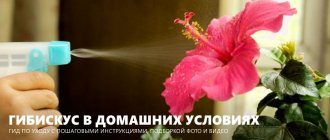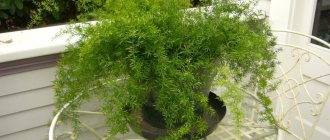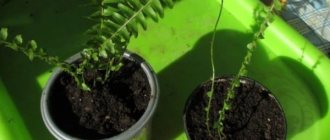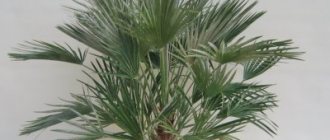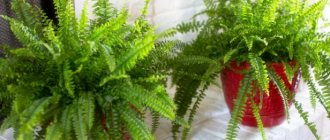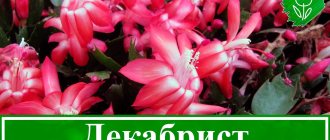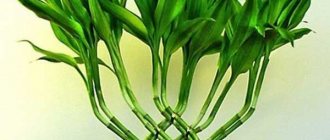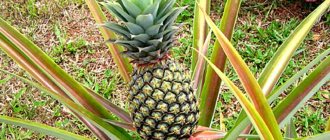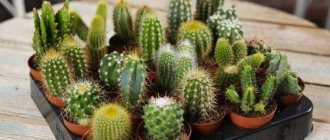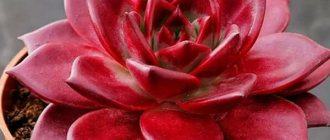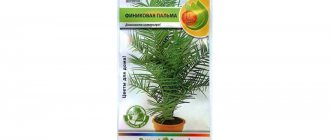Photo gallery
The plant is often mistaken for arrowroot, stromanta and calathea; it can be distinguished by its longer petioles and oval-elongated leaves.
Important! The plant is poisonous and poses a danger to children and pets.
Flowering and fruiting
The leaves are large, oval or oval-elongated, tapering towards the base, and arranged asymmetrically. Due to the short internodes, they seem to be collected in bunches.
In the evening the leaves close, rising up, and in the morning they fall. Thanks to the long petioles and large leaves, this process is accompanied by a characteristic rustling sound.
The main background of the leaves is bright or light green, with a clearly visible pattern of light green, yellow, gray or white stripes.
Small flowers of white-green, light pink, yellow or purple are collected in spikelet inflorescences pressed to the petioles.
At home it blooms extremely rarely.
Popular varieties
There are a large number of varieties of tropical flowers, so it is worth taking a closer look at those varieties that are best suited for planting in an apartment on a windowsill.
Ktenanta Oppenheim
Ktenanta Oppenheim creates a minimum of problems when cared for at home. It is often chosen by those who do not like to spend a lot of time caring for flowers. Oppenheim's ctenanta is a fairly tall species, growing in a pot up to 120 cm, in nature - up to almost 2 meters. The leaves of this variety are characterized by a lanceolate shape. They grow up to 20 or 30 cm in length. The foliage color of Oppenheim's calathea is alternating grayish-green and gray stripes.
Ktenanta Lubbersa
Ktenanta Lubbersa is another optimal variety for the windowsill. It is very easy to care for. The description of the variety is as follows: plant height - from 80 to 100 cm, leaves are oblong, dark green on top, pale green at the bottom with variegated veins.
Ctenanta Amagris
Many people know Ctenanta Amagris. This herbaceous perennial has oval oblong leaves, the length of which ranges from 15 to 25 centimeters. Their color is silver-green, very light, with thin stripes of a dark green hue along the veins. Another feature of the Amagris leaf is the burgundy tint of its lower part. Everything together looks very impressive and original.
Ctenanta pubescent
Among the ctenanta flowers of different species, the pubescent ctenanta is considered the most capricious. The plant is especially picky about air humidity, temperature and drafts. The flower looks very interesting. It has dark green, egg-shaped leaves with light green stripes. The latter look as if they were painted with paint using a brush. The pubescent variety grows up to 80 centimeters in height.
Ctenanta compressed
Another interesting variety that often finds a place on window sills is Calathea ctenanta compresses. This species grows to an average height of 90 cm. Features of Ctenantha compressa include glossy oval-shaped leaves, the length of which can reach 30 cm. They are usually located on high basal carts. The leaf blades are entire-edged and have a rich dark green hue.
Ktenanta Burle Maxi
Many people know Ktenanta Burle Maxi as the smallest plant in the family (up to 20 cm), which is characterized by very original colored leaves. The foliage itself is thick, almost rectangular in shape with wide dark stripes and a dark purple underside. In nature, Burle Maxi forms an almost continuous carpet consisting of bright leaves, the length of which is 10 cm, width - 5 cm.
Ctenanta Setosa
Ctenanta Setosa has elongated, dark green, ovoid leaves. The longitudinal stripes located on them are most often painted in a bluish or light green shade. The height of the plant can reach 80-90 centimeters. The perennial feels quite comfortable as a houseplant and does not require special conditions for successful cultivation.
Ktenanta Tricolor
The main feature of Ctenanta Tricolor is (as the name suggests) tricolor leaves. It is a hybrid of the Oppenheim variety, with striped yellow-green leaves and a bright purple underside. Externally, the flower resembles one of the Stromanth varieties.
Important! Ctenanta is a poisonous flower. It is not recommended to grow it in houses where pets live
Signs and superstitions
Ktenanta is the protector of the family hearth. Being in the spouses' bedroom helps strengthen family ties; in the children's room it helps a restless child calm down and find inner balance.
Helps get rid of fatigue and stress, create a calm atmosphere, find peace and understanding in the family.
According to Feng Shui, this is a plant with masculine Yin energy. It is recommended to place it in the work area, a teenager’s room, or a place where cheerful and noisy groups gather.
Helps avoid conflict situations, protects household members from illness, and eliminates negative energy.
Home care
Temperature and humidity
For normal growth and development of the ctenant, the air temperature in spring and summer should be +22-25 °C, in winter – +16-20 °C.
Due to hypothermia of the roots, the plant may die, so it is important to monitor the soil temperature, the optimal value is +20-22 °C.
Throughout the year, the humidity level should not fall below 70-80%; for this it is necessary to spray the plant and the air around it several times a day, use a humidifier, pour wet expanded clay into a tray, and cover the color with a plastic bag at night.
Lighting and comfortable place
Variegated varieties of ctenantha need diffused light; species with monochromatic leaves feel comfortable in partial shade.
Important! With an excess of bright light and under the influence of sunlight, the leaves of the plant fade.
Daylight should last at least 12-14 hours, and in winter additional artificial lighting will be required.
It is best to place the plant on the windowsill of a western or eastern window.
Shade tolerance
Shade tolerance depends on the leaves: the darker they are, the less light required. However, with a prolonged lack of light, the foliage will lose its brightness and the plant will stop growing.
Trimming
With uncontrolled growth, the ctenant loses its decorative effect: new shoots are too weak, due to lack of space, the leaves become small and turn yellow.
It is necessary to promptly and regularly remove long shoots and trim off limp and dried leaves, the place of which will be taken by new ones.
Care during the rest period
For growth and development, the ctenant does not need a pronounced period of rest. In order for her to rest enough in winter, lower the air temperature, reduce watering and fertilizing. Lighting requirements remain the same.
Features of the ctenant
All ctenants have the unique property of turning their leaves.
We already know that arrowroots raise their leaves up at night, as in prayer, and straighten them in the morning - this is how they orient themselves in space relative to the light, for this in their homeland - in the countries of Latin America, all arrowroots are called praying plants. But the pursuit of the sun (the source of light) is not the only reason for the leaves to turn. Sometimes movement is a pronounced defensive reaction; in sunny weather, the plant turns its leaves to reduce transpiration and excessive evaporation of moisture. If you look closely, the leaves turn along the light stream, sideways to the sun, with the edge of the leaf - so the heating surface is smaller than when the leaves are in a horizontal position. Moreover, what’s interesting is that the plant chooses what is most convenient for it - it can raise the leaves up or down, almost perpendicular to the floor. Please note that if your plant suddenly presses the leaves to the petioles on a spring or summer day, it may be hot or dry! The sun may no longer shine through the window, but the leaves are still pressed against the petioles. The fact is that in this position, moisture evaporation also occurs in a more economical mode - the humidity inside the bush, between the petioles and pressed leaves, is preserved better than when the leaves are spread out. By the way, all other arrowroots can behave in exactly the same way, but only in ctenanthas, stromanthus and some calathas (large long-petiolates), this process is more pronounced
In arrowroot, the growth of the stem is different - semi-creeping, forming many nodes, and the bush is compact, so the arrowroots also shrink from the heat, like bristling hedgehogs, or the leaves are pulled closer to the walls of the pot
By the way, all other arrowroots can behave in exactly the same way, but only in ctenanthas, stromanthus and some calathas (large long-petiolates), this process is more pronounced. In arrowroot, the growth of the stem is different - semi-creeping, forming many nodes, and the bush is compact, so the arrowroots also shrink from the heat, like bristling hedgehogs, or the leaves are pulled closer to the walls of the pot.
Thus, by observing your ctenanta (or other arrowroots), you can understand whether it is too hot, the sun is too intense, or both. To avoid burns and not overheat, the leaves will face the light. But if there is no sun, look at the thermometer - perhaps it is too stuffy, hot, remember how long ago you watered it. If the leaves become very dry, they become limp, like rags, but before that the plant will do everything to save moisture evaporation - it will shrink the leaves.
In some cases, the leaves on one side of the plant are lowered and raised on the other, so you can observe the reaction to the flow of warm air from the battery and the orientation of the plant towards the light source.
What kind of pot do you need?
The pot needs to be wide and not very high; during replanting, the new container should be 3-4 cm larger than the previous one. In a pot that is too spacious, water will accumulate, which will lead to the development of root rot.
The most suitable material is ceramics, due to the porosity of which it is easier to avoid waterlogging.
The flowerpot must have drainage holes. Walnut or eggshells, small pebbles, crushed stone, expanded clay, and tree bark are suitable for drainage.
Where can I buy it? Price range
Ktenanta is sold in online and offline flower shops, the cost depends on the size of the flowerpot, height and type of plant and averages 500 rubles. — 10 thousand rubles.
What to do after purchase?
A newly purchased plant should be given about 10-15 days to acclimatize. Replanting is required only in the case of a very overgrown root system.
What kind of soil is needed?
The soil must be nutritious, loose, moisture- and breathable, and have low acidity (pH up to 6.0).
You can use ready-made store-bought soil intended for arrowroot or azaleas, having previously enriched it with charcoal, or prepare it yourself by mixing:
- 1 part sand;
- 1 part peat;
- 2 parts leaf soil.
It is important to ensure that the substrate does not contain lime and spill it with a solution of manganese or treat it thermally to get rid of pests.
Expert opinion
Mokhov Andrey Petrovich
Graduated from KubSAU, specialty: agronomy
Before planting the ctenant, the soil must be checked: if, after squeezing in a fist, it remains free-flowing, you can begin replanting.
Feeding rules
Ktenanta does not like excess fertilizer; this must be taken into account and one must restrain one’s desire to frequently water it with nutritional compounds. Her well-being is adversely affected by increased levels of calcium and nitrogen in the soil. In the cold season, it will be enough to feed your pet once a month. In spring and summer, this procedure should be performed more often - once every two weeks.
What fertilizer should I choose for this? It is best to take complex formulations for indoor decorative foliage plants. Fertilizer in liquid form is considered the most convenient. And one moment. The instructions always indicate a high dosage. It is recommended to use it at half dose.
But there is another option. If you have prepared high-quality soil, the plant will not lack nutrients. An annual repotting serves the same purpose. If you adhere to the principles of regularly updating the soil in pots, then you don’t have to think about fertilizing. They will simply be superfluous.
Reproduction
Ctenanta is propagated by cuttings, dividing the bush and seeds.
For reproduction you will need:
- soil mixture;
- water;
- flowerpot;
- growth stimulants – “Zircon”, “Epin”, “Kornevin”;
- knife;
- charcoal or cinnamon;
- polyethylene.
By cuttings
For cuttings you need:
- cut branches 8-10 cm long, each cutting should have 1-2 internodes and 2-3 leaves;
- treat the sections with crushed or activated carbon and dip in a solution of “Epin”, “Zircon” or “Kornevin”;
- place the cuttings in a container with water;
- when the roots grow to 0.5-1 cm, transplant into soil, spray and cover with polyethylene to create a greenhouse effect;
- place the greenhouse in a room with bright, diffused lighting and a temperature of +22-25 °C;
- regularly ventilate the greenhouse and water the seedlings;
- After the leaves appear, remove the greenhouse and care for the seedlings as if they were an adult plant.
Reference! Cuttings should be harvested in late spring or early summer.
Dividing the bush
During transplantation, it is necessary to cut the roots into several parts with a sharp sterile knife so that each has several leaves and a developed section of root.
Sprinkle the sections with crushed charcoal or cinnamon powder and dry for several hours.
Place the cuttings in separate containers, spray and cover with polyethylene. As the soil dries, water with a weak solution of a growth stimulator - “Epin” or “Kornevin”.
To speed up the rooting process, it is necessary to provide bright lighting, a temperature of +25-27 °C and use bottom heating. In this way, only large and completely healthy plants over 5 years old can be propagated.
Seeds
Ctenanta is extremely rarely grown from seeds due to the difficulty of obtaining them at home.
To germinate seeds, it is necessary to keep them in greenhouse conditions in constant humidity, in bright light and at a temperature of at least +20 °C, using bottom heating.
Entrances appear after a month, after another 30-40 days they can be planted in separate containers.
Botanical description
The leaf mass is an elongated leaf up to 40 cm, sitting on a long petiole. And the colors can be different; on a dark green background there are strokes and spots of different shades:
- white;
- light green;
- yellowish tints.
Flowering occurs in small spikelets of white or red shades. The plant itself, depending on the species, has an average height of 30 cm.
The flowering phase cannot be interrupted. If you remove a peduncle, after a while the next one will appear. By constantly removing flower shoots, the gardener will not improve the condition of the flower, but will destroy it.
Because of the variegated leaves, it is easy to confuse ctenanta with calathea. Both plants have very beautiful patterned leaves. Even in books, the titles are not always correct. If we consider all the varieties of ctenanta, then the one that is most similar to calathea is the Berl-Marx ctenanta. It has stripes, due to which in its native conditions it is called zebra grass. Even botanists who have not arrived at a single taxonomy for the family add to the confusion. Different authors classify the same plants into different groups. Here are a few points that will help distinguish ctenanta from calathea:
- Leaves . The petioles of the ctenanthus are usually several times longer than the leaves. The leaf blade is elongated, pointed. The shape of the leaf rosette is flat at the bottom. Some species of ctenants (C. lubbersii) produce a shoot from the main rosette, on which a new bunch is formed. There seems to be a formation of 2-3 levels. But the leaves of calathea are most often larger than the petiole. Sometimes they are collected in a rounded rosette or arranged singly.
- Inflorescences . The main difference is in the shape of the inflorescences. In the ctenanta they are like a scallop. By the way, the name of the genus Ctenanthe comes from the Greek ctenos - comb. Kalatyas have inflorescences comparable to spikelets and baskets. They bloom a little more often. Of course, getting arrowroot to bloom at home is a difficult task, so distinguishing two similar plants using this method is extremely difficult.
Watering
In spring and summer, the plant needs to be watered approximately every 2 days, in winter - no more than 2 times a week. The regularity of watering depends on the drying speed of the top layer of soil - it should dry 1.5-2 cm deep.
Watering is carried out under the leaves; due to water getting on the leaves, they may change color.
The water should be soft - rain, melt, settled or filtered, slightly above room temperature.
If you are going on vacation
To maintain moisture during a long absence, you need to place the flowerpot on wet pebbles or expanded clay, cover the soil with damp sphagnum moss and cover the plant with a plastic bag.
Fertilizers
During the growing season, the plant requires regular feeding with fertilizers for leaf crops. They should be added at this time once every 2 weeks. During the dormant period, fertilization should occur no more than once every 1.5 months.
Diseases. Table
| Disease | Signs | Treatment |
| Root rot | The leaves dry and wither, the roots darken and rot. | A replantation is required with a complete replacement of the soil and removal of damaged roots, treatment with fungicides - “Alirin” or “Fitosporin” |
| Powdery mildew | Leaves seem to be dusted with flour | Spray the plant with a solution based on benomyl, theophanate-methyl |
| Sooty fungus | Ktenanta looks like it's covered in soot | Treat affected areas with soap |
Types of ctenanta with photos and names
Ctenanta refers to plants, different species of which differ greatly in appearance from each other.
Oppenheimiana (Ctenanthe oppenheimiana)
One of the most popular types. We love flower growers for their original, catchy appearance and relative unpretentiousness to care and maintenance conditions.
The leaves are oblong, narrow at the base, up to 40 cm in length, dark green in color with striking stripes of different colors, from light green to light silver. The inner side of the leaf is purple. The bush can grow up to 1 meter in height. A remarkable feature is the mobility of the leaves, which curl up with the onset of darkness. At the same time, a slight rustling sound is produced, which can be heard in complete silence, especially if the bush is large. Looks great in the interior of any room.
Ctenanthe lubbersiana
The bush is compact, no more than 75 cm high. It differs from others in the juicy, bright green color of the foliage and original stripes, similar to the feathers of light yellow birds. Another peculiarity is that the foliage retains its color in shading and even in the complete absence of sunlight, under artificial lighting.
Common mistakes made by amateur gardeners
The ctenant reacts to any mistakes in care or unsatisfactory living conditions by deteriorating her appearance. And since its main value in the eyes of a gardener is its bright, variegated foliage, you need to learn to correctly interpret the signals sent by the plant in order to know what exactly it doesn’t like.
Table: how the client reacts to errors in care
| What does the plant look like? | What is the reason? |
| The stems lose their tone and droop. Ctenanta grows slowly. | Temperature too high. |
| The leaves curl into a tube and become covered with brownish spots. | Moisture deficiency. This applies to both watering and spraying. |
| The leaves change color to yellow-brown. | Deficiency or, conversely, excess of nutrients in the soil. |
| The leaves fade, dry out, and the variegated color disappears. | The lighting is too bright. |
| The leaves fall without drying out. | Low air humidity or too much watering. Or the plant is in a draft. |
| The bases of the stems and leaf petioles turn black. | Low temperature combined with high humidity. |
Curled leaves of the ctenantha indicate that the plant suffers from moisture deficiency
